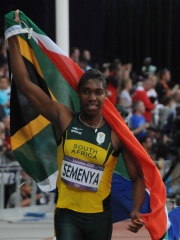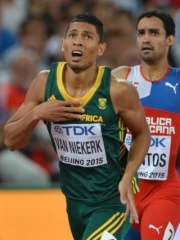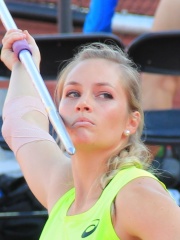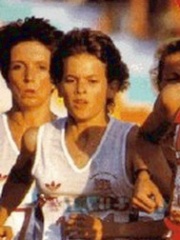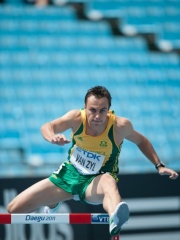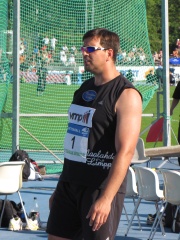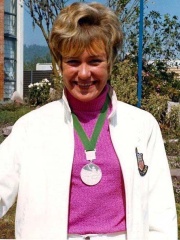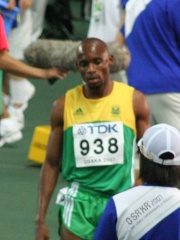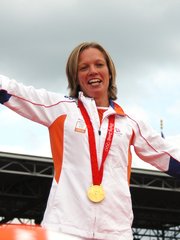
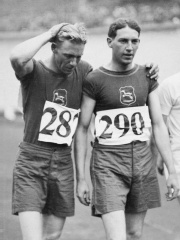
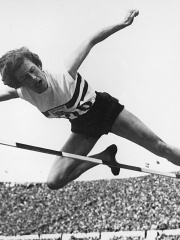

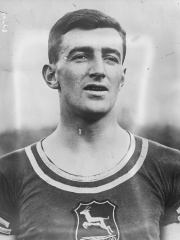
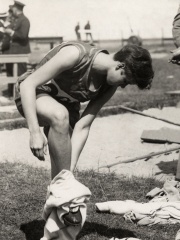
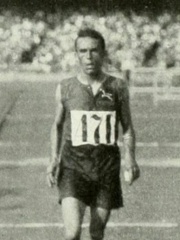

The Most Famous
ATHLETES from South Africa
This page contains a list of the greatest South African Athletes. The pantheon dataset contains 6,025 Athletes, 138 of which were born in South Africa. This makes South Africa the birth place of the 28th most number of Athletes behind Jamaica, and Argentina.
Top 10
The following people are considered by Pantheon to be the top 10 most legendary South African Athletes of all time. This list of famous South African Athletes is sorted by HPI (Historical Popularity Index), a metric that aggregates information on a biography's online popularity. Visit the rankings page to view the entire list of South African Athletes.

1. Reggie Walker (1889 - 1951)
With an HPI of 64.58, Reggie Walker is the most famous South African Athlete. His biography has been translated into 24 different languages on wikipedia.
Reginald Edgar Walker (16 March 1889 in Durban – 5 November 1951) was a South African athlete and the 1908 Olympic champion in the 100 metres.

2. Sid Atkinson (1901 - 1977)
With an HPI of 63.24, Sid Atkinson is the 2nd most famous South African Athlete. Her biography has been translated into 22 different languages.
Sidney James Montford Atkinson (14 March 1901 – 31 August 1977) was a South African athlete, winner of 110 m hurdles at the 1928 Summer Olympics.

3. Esther Brand (1922 - 2015)
With an HPI of 62.11, Esther Brand is the 3rd most famous South African Athlete. Her biography has been translated into 29 different languages.
Esther Cornelia Brand (née van Heerden; 29 September 1922 – 20 June 2015) was a South African athlete. She competed at the 1952 Summer Olympics and won a gold medal in the high jump, placed 20th in the discus throw. She was the first African woman to win an Olympic track and field event. Brand was ranked world #1 in the high jump in 1940–41 and 1952, #3 in 1951 and #5 in 1939. In 1941 she equaled the world record of 1.66 m. Born in Springbok, Northern Cape, she attended Maitland High School in Cape Town, South Africa. She died after a fall in 2015.

4. Lawrence Stevens (1913 - 1989)
With an HPI of 57.86, Lawrence Stevens is the 4th most famous South African Athlete. His biography has been translated into 19 different languages.
Lawrence Stevens (25 February 1913 – 17 August 1989) was a South African boxer who competed in the 1932 Summer Olympics. He was born in Johannesburg and died in Durban, Natal. Both of his parents were born and raised in Johannesburg, all four of his grandparents were immigrants from England. In 1930, he won the featherweight silver medal at the 1930 British Empire Games after losing the final to Frank Meachem. Two years later, he won the gold medal in the lightweight class after winning the final against Thure Ahlqvist. Stevens was mentioned on the British quiz show Pointless on 26 January 2016, where South Africa was a "pointless answer" in the category of "Countries that won a gold medal winners at the 1932 or 1936 Summer Olympics". Of Cornish descent, he was known as 'the Gentleman Boxer'. On the way home from the Olympics, a fellow passenger in the liner persistently asked Laurie to go a few rounds with him in the gym, eventually Laurie agreed and after two rounds, woke up to the fact that the fellow passenger was trying to knock him out, so that he could claim an Olympic Gold scalp. Laurie said 'enough Chum' and that was the end of a dream. He fought in the Desert during the Second World War. In the postwar years he owned a factory and a sports shop in Rissik Street, Johannesburg. A handsome, laughing man, he always cried when recalling the raising of the Union Flag and the playing of God Save The King on the day he won his Olympic gold medal.
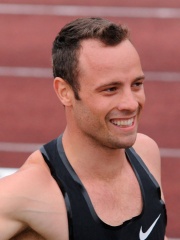
5. Oscar Pistorius (b. 1986)
With an HPI of 56.96, Oscar Pistorius is the 5th most famous South African Athlete. His biography has been translated into 65 different languages.
Oscar Leonard Carl Pistorius ( pist-OR-ee-əs, Afrikaans: [pəˈstuəriœs]; born 22 November 1986) is a South African double amputee, former professional sprinter, and convicted murderer. He was the 10th athlete to compete at both the Paralympic Games and Olympic Games. Pistorius ran in both nondisabled sprint events and in sprint events for below-knee amputees. Both of his legs were amputated below the knee when he was 11 months old as a result of a birth defect; he was born missing the outsides of both feet and both fibulas. Pistorius's athletic career ended when he was convicted of murder in 2015. He was first convicted of culpable homicide of his then-girlfriend, Reeva Steenkamp, which was subsequently upgraded to murder upon appeal. After becoming a Paralympic champion, Pistorius attempted to enter nondisabled international competitions, over persistent objections by the International Association of Athletics Federations (IAAF) and arguments that his artificial limbs gave an unfair advantage. Pistorius prevailed in this legal dispute. At the 2011 World Championships in Athletics, Pistorius was the first amputee to win a nondisabled world track medal. At the 2012 Summer Olympics, Pistorius was the first double-leg amputee participant. On 14 February 2013, Pistorius shot and killed his girlfriend, Reeva Steenkamp, a paralegal and model, in his Pretoria home. He claimed he had mistaken Steenkamp for an intruder hiding in the bathroom. He was arrested and charged with murder. At his trial the following year, Pistorius was found not guilty of murder, but guilty of culpable homicide. He received a five-year prison sentence for culpable homicide and a concurrent three-year suspended sentence for a separate reckless endangerment conviction both in October 2014. Pistorius was temporarily released on house arrest in October 2015 while the case was presented on appeal to a panel at the Supreme Court of Appeal of South Africa, which overturned the culpable homicide verdict and convicted him of murder. In July 2016, Judge Thokozile Masipa extended Pistorius's sentence to six years. On appeal by the state for a longer prison sentence, the Supreme Court of Appeal increased the prison term to a total of 15 years less time served. Pistorius was released on parole on 5 January 2024 after serving a total of 8.5 years in prison, in addition to seven months' house arrest.

6. Bevil Rudd (1894 - 1948)
With an HPI of 56.39, Bevil Rudd is the 6th most famous South African Athlete. His biography has been translated into 24 different languages.
Bevil Gordon D'Urban Rudd (5 October 1894 – 2 February 1948) was a South African athlete, the 1920 Olympic Champion in the 400 metres.

7. Marjorie Clark (1909 - 1993)
With an HPI of 54.95, Marjorie Clark is the 7th most famous South African Athlete. Her biography has been translated into 18 different languages.
Marjorie Rees Clark (later Smith, 6 November 1909 – 15 June 1993) was a South African former track and field athlete, who competed in the 1928 Summer Olympics and in the 1932 Summer Olympics. She was born in Bulwer, KwaZulu-Natal and competed for the Albion Ladies Athletic Club.

8. Christian Gitsham (1888 - 1956)
With an HPI of 54.93, Christian Gitsham is the 8th most famous South African Athlete. His biography has been translated into 16 different languages.
Christopher William Gitsham (15 October 1888 – 16 June 1956) was a South African athlete, who mainly competed in the men's marathon. Gitsham competed for South Africa at the 1912 Summer Olympics held in Stockholm, Sweden where he won the silver medal in the men's marathon event. He also competed in the marathon at the 1920 Summer Olympics, but did not finish.

9. Daphne Hasenjäger (b. 1929)
With an HPI of 54.70, Daphne Hasenjäger is the 9th most famous South African Athlete. Her biography has been translated into 16 different languages.
Daphne Lilian Evelyn Hasenjäger (née Robb; born 2 July 1929) is a South African former sprinter. She competed for South Africa at the 1952 Summer Olympics, held in Helsinki, Finland, in the 100 metres, where she won the silver medal, splitting Australians Marjorie Jackson and Shirley Strickland.
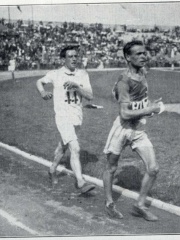
10. Cecil McMaster (1895 - 1981)
With an HPI of 53.76, Cecil McMaster is the 10th most famous South African Athlete. His biography has been translated into 15 different languages.
Cecil Charles McMaster (5 June 1895 – 11 September 1981) was a South African athlete, who competed in two consecutive Summer Olympics for his native country, starting in 1920. He won the bronze medal at the 1924 Summer Olympics held in Paris, France in the 10 kilometre walk. He was born in Port Elizabeth.
People
Pantheon has 138 people classified as South African athletes born between 1888 and 2005. Of these 138, 125 (90.58%) of them are still alive today. The most famous living South African athletes include Oscar Pistorius, Daphne Hasenjäger, and Stefan Mitrović. The most famous deceased South African athletes include Reggie Walker, Sid Atkinson, and Esther Brand. As of April 2024, 7 new South African athletes have been added to Pantheon including Sven Schmid, Marilyn Agliotti, and Mark Plaatjes.
Living South African Athletes
Go to all RankingsOscar Pistorius
1986 - Present
HPI: 56.96
Daphne Hasenjäger
1929 - Present
HPI: 54.70
Stefan Mitrović
HPI: 49.17
Caster Semenya
1991 - Present
HPI: 47.18
Wayde van Niekerk
1992 - Present
HPI: 46.71
Kelsey-Lee Barber
1991 - Present
HPI: 45.60
Zola Budd
1966 - Present
HPI: 45.59
Péter Nagy
HPI: 44.88
Zhang Jian
HPI: 44.04
Elana Meyer
1966 - Present
HPI: 44.03
L. J. van Zyl
1985 - Present
HPI: 43.88
Frantz Kruger
1975 - Present
HPI: 43.50
Deceased South African Athletes
Go to all RankingsReggie Walker
1889 - 1951
HPI: 64.58
Sid Atkinson
1901 - 1977
HPI: 63.24
Esther Brand
1922 - 2015
HPI: 62.11
Lawrence Stevens
1913 - 1989
HPI: 57.86
Bevil Rudd
1894 - 1948
HPI: 56.39
Marjorie Clark
1909 - 1993
HPI: 54.95
Christian Gitsham
1888 - 1956
HPI: 54.93
Cecil McMaster
1895 - 1981
HPI: 53.76
Clarence Walker
1898 - 1957
HPI: 52.41
Clarence Oldfield
1899 - 1981
HPI: 52.29
Lillian Board
1948 - 1970
HPI: 49.45
Mbulaeni Mulaudzi
1980 - 2014
HPI: 44.57
Newly Added South African Athletes (2025)
Go to all RankingsSven Schmid
1978 - Present
HPI: 40.42
Marilyn Agliotti
1979 - Present
HPI: 39.59
Mark Plaatjes
1962 - Present
HPI: 39.27
Ramon di Clemente
1975 - Present
HPI: 38.68
Marius Corbett
1975 - Present
HPI: 37.10
Robin Bell
1977 - Present
HPI: 36.66
Llewellyn Herbert
1977 - Present
HPI: 35.03
Overlapping Lives
Which Athletes were alive at the same time? This visualization shows the lifespans of the 12 most globally memorable Athletes since 1700.


